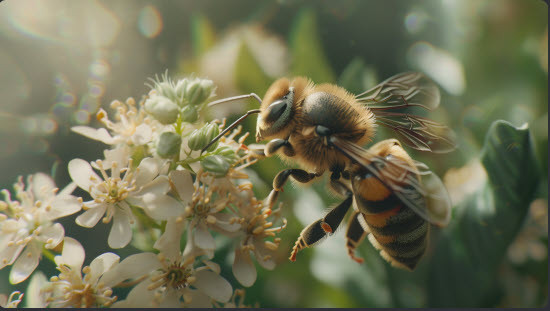Would you prefer to listen to a short podcast discussion about this article? Click on the audio below.
Bees are essential pollinators that help to pollinate about 70% of our crops, which provide us with food, fibre, and medicines. However, they are facing numerous challenges, including habitat loss, pesticide exposure, and climate change. As gardeners, we can make a difference by creating a haven that provides them with food, shelter, and water. In this article, we will explore how to create a buzzworthy garden that attracts bees and beautifies your landscape.
The Buzzworthy Garden: Welcome to a Haven for Bees!
A buzzworthy garden is a garden that provides a safe haven for them to thrive and prosper. It is a garden that is filled with an abundance of nectar and pollen sources, and it is free from harmful pesticides. By creating a buzzworthy garden, you are not only supporting them, but you are also supporting your local ecosystem. A bee-friendly garden is a sustainable garden that benefits both the environment and the people.
How to Plant a Pollinator Paradise
The first step in creating the haven is to plant plants that provide the honey collectors with a diverse source of nectar and pollen. Our busy friends are attracted to colourful flowers that are easy to access, so choose plants that have single-layered petals or open flowers. Native plants are an excellent choice because they have evolved with the local swarm and provide them with the food they need. Some examples of bee-friendly plants include wildflowers, herbs, shrubs, and trees.
Creating a Buzz: Tips for Attracting Bees to Your Garden
To attract them to your garden, you need to create a welcoming environment that provides food, shelter, and water. Bees need a source of water to drink and cool down, so provide them with a shallow dish of water with stones for them to land on. They also need places to rest and nest, so leave some areas of your garden unmowed and provide them with nesting boxes or artificial hives. Avoid using pesticides and herbicides that can harm bees and other beneficial insects.

Buzzing Visitors: Learn About the Different Types
There are over 20,000 species in the world, and each one has unique characteristics and behaviours. Some are solitary, while others live in colonies. Some bees are ground nesters, while others are cavity nesters. Learning about the different types can help you understand their needs and preferences. Some common types of bees that you may see in your garden include honey bees, bumblebees, mason bees, and leafcutter bees.
Beautiful Garden: How to Design a Buzzworthy Landscape
Designing a buzzworthy landscape involves creating a balance between form and function. You want your garden to look beautiful while also providing the honey collectors with the resources they need. Consider the colors, textures, and shapes of the plants you choose, and how they will look throughout the seasons. Create a variety of heights and layers to provide them with places to forage and rest. Incorporate hardscaping elements such as paths, walls, and benches to add structure and interest to your garden.
Join the Movement: Becoming an Advocate
Creating a buzzworthy garden is just the beginning of becoming an advocate. There are many ways you can take action to support all pollinators (wasps also pollinate). You can support local beekeepers by buying honey from them or renting hives for your garden. You can also participate in citizen science projects that help to monitor bee populations and track their behaviour. Spread the word about their importance and encourage others to create their own havens. Together, we can make a difference in their world.
Creating the haven is not only beneficial to our buzzy friends, but it is also a rewarding experience for gardeners. By following these tips, you can create a beautiful, sustainable, and buzzing garden that provides a home for our busy friends and other pollinators. Remember, every little action counts, and together we can help to protect and preserve the precious world of bees. Happy gardening!

If you need any further information or assistance with this article, don't hesitate to Contact Us




















